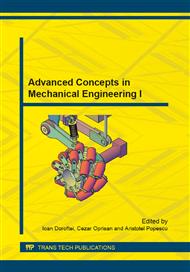p.3
p.9
p.17
p.23
p.29
p.35
p.41
p.47
p.55
Consideration Regarding the Inverse Kinematics of a Rowing Skiff under the Action of the Oars Movement
Abstract:
The paper deals with the kinematical approach of the trajectory of movement of an academic rowing skiff with a view to determine a given racing speed of the boat. It uses inverse kinematics since this method allows obtaining analytical calculus formulas for the movement of paddles in their two moments of motion: active and passive strokes. Movement of the paddles while following an arc-shaped trajectory outlining a sphere-like quadrilateral requires different values of amplitude of angular displacement of the paddles according both to anthropometrical values of the athlete and to his physical and technical training. The numerical application is made for several values of these angles which define the arcs of the circle for active and passive curves and for the moments between the two strokes (angle of the paddle while slicing in and out the water). These amplitudes of angular displacement are being considered, from the point of view of the horizontal component, equal to the speed of the skiff while imposing the linear speed of the paddle, and they would help determining movement frequencies of the paddle while following the sphere-like quadrilateral trajectory.
Info:
Periodical:
Pages:
29-34
Citation:
Online since:
October 2014
Authors:
Keywords:
Price:
Сopyright:
© 2014 Trans Tech Publications Ltd. All Rights Reserved
Share:
Citation:


